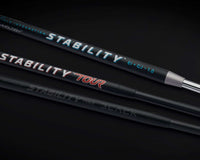Most people assume-
"The slower the swing or club speed, the higher the loft of the driver to optimize both carry and roll."
But that may not be the case...
Loft is directly related to launch of the ball. Yes, launch is dictated by club dynamics but primarily, we use loft to optimize spin & impact location. In layman terms, spin of the ball acts like 'drag/lift' for an aircraft. For example, too much spin & the ball reaches peak height too quick. It will also land way too steep (above 40-45 degrees).
As we want a mid to high trajectory for the driver, it's important to optimize spin/launch to get the best out of your shot. Many websites & fitters may tell you that it's important to be around 2200-2500 rpm for a driver shot but every player has a different swing. To improve consistency, it's critical to find the right loft to get the best spin/launch. That very well could be 3500 rpm or as low as 1900 rpm.
On another note, not all of us can swing it 120mph & have 300 yard carries. We still want a shallow landing angle (~32 degrees) for optimized roll & improved total. A shallow landing angle is another indicator of the correct loft you need to play.
Consider this scenario from a fitting we did recently. The player was using a Callaway Big Berta 9° with a 65g stiff shaft & struggled with a bad hook.
After testing about five different brands, the player narrowed down to the PING G425 models. We tested with MCA Tensei, Alta CB & LAGP shafts. The preference was for the LST; the player liked the feel & look. Performance was consistent with the Alta CB 55g R flex shaft & it's characteristics matched up with swing dynamics.
Launch Monitor: TrackMan 4
Golf ball: Titleist Pro V1
Length: 45.75"
Grip: Golf Pride Tour Velvet Standard 60R
First up, the 9° LST head.

Result:
- Ball-speed - 138 mph
- Smash Factor - 1.48
- Spin rate - 3123 rpm
- Carry (avg) - 227y
- Total (avg) - 252y
- Height - 80ft
- Landing angle - 34 deg
With the spin at an average of 3123rpm, we felt that the spin was a little high & not good enough to provide a powerful ball flight. The dispersion was not tight enough as well with a spread of about 30-35y.
Logic may dictate that reducing loft would make complete sense to reduce spin & improve carry. But, the player was not happy with the way the lower loft (9 & below) sat at address. He felt that there's a higher tendency to leave the face open. We may also reduce launch & in turn affect carry distances as well.
Even though the impact (heat map) is great, modern day heads have the ability to produce high ball speeds across the entire face. That's what the concept of forgiveness does for your golf game. As fitters, it's important to consider all available factors to improve performance & what the player wants as well. Perfect data may not always be required. Understanding how loft as an angle can affect impact location is important. So we decided to test the 10.5° LST head.

By increasing loft by 1.5° (9° to 10.5°), we shifted impact location to the lower half of the head. This resulted in,
- Improved ball speed by 3 mph to 141 mph
- Reducing spin to 2651 rpm (average). A drop of approx 500 rpm.
- Improving average carry by 8 yards with a penetrating trajectory.
- Reduced/shallow landing angle to improve total by another 12-14y
- Consistent ball flight & shape.
- Moving to a tighter dispersion with a 7y draw.
So next time, you are out buying a new driver, it's important to get fit for the right loft. Not only can it affect height but also distance & dispersion. That can essentially make or break your game.
Do visit our ClubWorks studio in Bangalore & get fit for your next driver!



